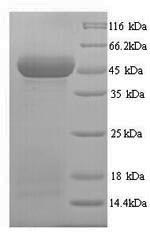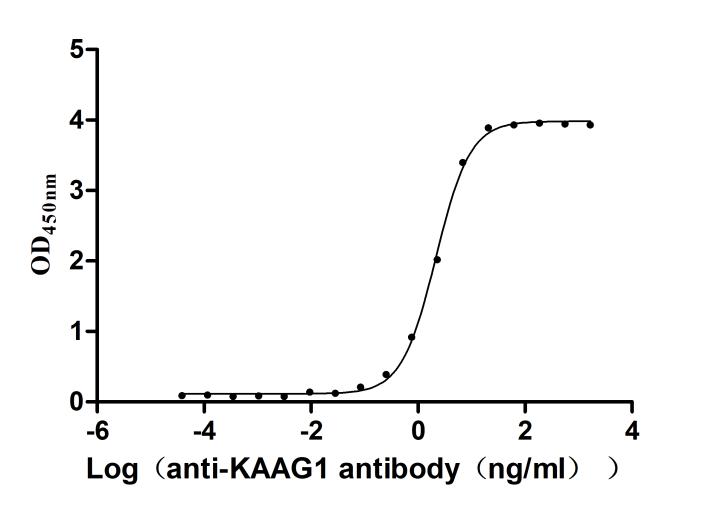Recombinant Human Protein Wnt-10a (WNT10A)
In Stock-
货号:CSB-YP884424HU
-
规格:¥1500
-
图片:
-
其他:
产品详情
-
纯度:Greater than 90% as determined by SDS-PAGE.
-
基因名:
-
Uniprot No.:
-
别名:FLJ14301; OODD; Protein Wnt-10a; SSPS; STHAG4; Wingless type MMTV integration site family member 10A; WN10A_HUMAN; wnt10a
-
种属:Homo sapiens (Human)
-
蛋白长度:Full Length of Mature Protein
-
来源:Yeast
-
分子量:44.4kDa
-
表达区域:36-417aa
-
氨基酸序列MPRSAPNDILDLRLPPEPVLNANTVCLTLPGLSRRQMEVCVRHPDVAASAIQGIQIAIHECQHQFRDQRWNCSSLETRNKIPYESPIFSRGFRESAFAYAIAAAGVVHAVSNACALGKLKACGCDASRRGDEEAFRRKLHRLQLDALQRGKGLSHGVPEHPALPTASPGLQDSWEWGGCSPDMGFGERFSKDFLDSREPHRDIHARMRLHNNRVGRQAVMENMRRKCKCHGTSGSCQLKTCWQVTPEFRTVGALLRSRFHRATLIRPHNRNGGQLEPGPAGAPSPAPGAPGPRRRASPADLVYFEKSPDFCEREPRLDSAGTVGRLCNKSSAGSDGCGSMCCGRGHNILRQTRSERCHCRFHWCCFVVCEECRITEWVSVCK
Note: The complete sequence including tag sequence, target protein sequence and linker sequence could be provided upon request. -
蛋白标签:N-terminal 6xHis-tagged
-
产品提供形式:Liquid or Lyophilized powder
Note: We will preferentially ship the format that we have in stock, however, if you have any special requirement for the format, please remark your requirement when placing the order, we will prepare according to your demand. -
缓冲液:Tris-based buffer,50% glycerol
-
储存条件:Store at -20°C/-80°C upon receipt, aliquoting is necessary for mutiple use. Avoid repeated freeze-thaw cycles.
-
保质期:The shelf life is related to many factors, storage state, buffer ingredients, storage temperature and the stability of the protein itself.
Generally, the shelf life of liquid form is 6 months at -20°C/-80°C. The shelf life of lyophilized form is 12 months at -20°C/-80°C. -
货期:3-7 business days
-
注意事项:Repeated freezing and thawing is not recommended. Store working aliquots at 4°C for up to one week.
-
产品描述:
Recombinant Human WNT10A Protein with an N-terminal 6xHis-tag is a full Length of mature protein expressed in the yeast. The sequence used to prepare this recombinant protein corresponds to residues Met36-Lys417 of human WNT10A. Its purity is greater than 90% as determined by SDS-PAGE. A molecular mass band of 45-60 kDa was visualized on the SDS-PAGE gel. This recombinant WNT10A protein may be used to produce specific antibodies or in the studies of WNT10A-related cancers.
WNT10A is an oncogenic protein related to the carcinogenesis and progression of renal cell carcinoma and ovarian cancer through the activation of canonical Wnt/β-catenin signaling. Ke-Yong Wang etc. showed that WNT10A may play a critical role in wound healing/scarring by modulating the expression and synthesis of collagen.
-
Datasheet & COA:Please contact us to get it.
相关产品
靶点详情
-
功能:Ligand for members of the frizzled family of seven transmembrane receptors. Functions in the canonical Wnt/beta-catenin signaling pathway. Plays a role in normal ectoderm development. Required for normal tooth development. Required for normal postnatal development and maintenance of tongue papillae and sweat ducts. Required for normal proliferation of basal cells in tongue filiform papillae, plantar epithelium and sweat ducts. Required for normal expression of keratins in tongue papillae. Required for normal expression of KRT9 in foot plant epithelium. Required for normal hair follicle function.
-
基因功能参考文献:
- No up-regulation of Wnt10A and IGF-1 mRNA was observed with 1,550-nm Er:Glass fractional laser treatment of androgenetic alopecia. PMID: 30096107
- Human and mouse WNT10A mutant palmoplantar and tongue epithelia also display specific differentiation defects that are mimicked by loss of the transcription factor KLF4. PMID: 28589954
- WNT10a rs201002930 significantly decreased the risk of cleft lip with cleft palate and cleft palate only. PMID: 29356097
- WNT10A mutation is associated with tooth agenesis. PMID: 30046887
- High WNT10A expression is associated with papillary thyroid carcinoma. PMID: 28677753
- Mild to severe oligodontia was observed in all patients bearing biallelic WNT10A mutations. PMID: 28105635
- The development of maxillary canine, maxillary second molar and mandibular second molar was statistically significantly delayed in patients with WNT10A variants compared with patients without variants. The impact of WNT10A variants on dental development increases with presence of the nonsense c.(321C>A p.(C107*)) variant and the number of missing teeth PMID: 27650966
- Results from genetic analysis revealed that all seven individuals were homozygous or compound heterozygous for WNT10A mutations suggesting that tooth agenesis and/or peg-shaped crowns of primary mandibular incisors, severe oligodontia of permanent dentition as well as ectodermal symptoms of varying severity may be predictors of bi-allelic WNT10A mutations of importance for diagnosis, counselling and follow-up. PMID: 27881089
- miR-378a-3p suppresses hepatic stellate cell activation, at least in part, via targeting of Wnt10a, supporting its potential utility as a novel therapeutic target for liver fibrosis. PMID: 27832641
- Wnt10a/beta-catenin signaling pathway is able to exacerbate keloid cell proliferation and inhibit the apoptosis of keloid cells through its interaction with TERT. PMID: 27771714
- risk of hypodontia may be related to the WNT10A polymorphism. Our results also confirm the importance of the Wnt pathway in tooth development. PMID: 27050986
- WNT10A promotes the proliferation of DPCs and negatively regulates their odontoblastic differentiation. PMID: 25134734
- WNT10A exonic variant increases the risk of keratoconus by decreasing corneal thickness PMID: 26049155
- p.Arg113Cys, p.Phe228Ile, newly identified p.Arg171Leu may represent aetiological mutations underlying MLIA w/associated dental anomalies, implicating coding variants in WNT10A gene PMID: 25545742
- this study demonstrated that common variations in WNT10A have pleiotropic effects on the morphology of ectodermal appendages. PMID: 25612571
- WNT10A may induce kidney fibrosis and associate with kidney dysfunction in acute interstitial nephritis. PMID: 25054240
- transmission disequilibrium test showed transmitted disequilibrium in C392T. we found an association between the C392T variant and nonsyndromic oral clefts. PMID: 24957471
- High WNT10A expression promotes an invasive and self-renewing phenotype in esophageal squamous cell carcinoma PMID: 25795715
- Patients with bi-allelic WNT10A mutations have severe tooth agenesis. PMID: 24700731
- The novel c.-14_7delinsC mutation might be the etiological variant of the WNT10A gene responsible for the permanent tooth agenesis in the Egyptian family. PMID: 24798981
- Barrel-shaped mandibular incisors and severe hypodontia appear to be associated with homozygous or compound heterozygous mutations of WNT10A. PMID: 24458874
- Our study has demonstrated for the first time that agenesis of the maxillary permanent canines is a distinct entity, associated with mutations in WNT10A. PMID: 24311251
- WNT10A mutations account for (1/4) of population-based isolated oligodontia and show phenotypic correlations. PMID: 24449199
- WNT10A and EDA digenic mutations could result in oligodontia and syndromic tooth agenesis in the Chinese population. Moreover, our results will greatly expand the genotypic spectrum of tooth agenesis. PMID: 24312213
- involvement of PAX9, EDA, SPRY2, SPRY4, and WNT10A as risk factors for MLIA. uncovered 3 strong synergistic interactions between MLIA liability and MSX1-TGFA, AXIN2-TGFA, and SPRY2-SPRY4 gene pairs. 1st evidence of sprouty genes in MLIA susceptibility. PMID: 24554542
- Nine pathogenic mutations within the coding region of the WNT10A gene were identified in 26 out of 42 (62%) Polish patients with non-syndromic tooth agenesis. PMID: 23167694
- WNT10A variants were associated with non-syndromic tooth agenesis from mild to severe tooth agenesis, and the more severe tooth agenesis, the stronger association. PMID: 24043634
- Mutations in WNT10A are frequently involved in oligodontia associated with minor signs of ectodermal dysplasia. PMID: 23401279
- Expression studies in human hair follicle tissue suggests that WNT10A has a functional role in androgenetic alopecia etiology. PMID: 23358095
- the expression level of Wnt10a is higher in endometrioid carcinoma than in non-endometrioid subtypes; however, the underlying mechanism remains unclear. PMID: 23135473
- WNT10A acts as an autocrine oncogene both in renal cell carcinoma carcinogenesis and progression by activating WNT/beta-catenin signaling. PMID: 23094073
- In a panel of 34 patients with isolated hypodontia, the candidate gene WNT10A and the genes MSX1, PAX9, IRF6 and AXIN2 have been sequenced. WNT10A mutations were identified in 56% of the cases with non-syndromic hypodontia. PMID: 22581971
- patients harboring WNT10A mutations displayed distinctive clinical features (marked dental phenotype, no facial dysmorphism) PMID: 20979233
- We observed a marginally significant interaction between WNT10 rs10177996 (intron 1) and an individual's proportion of calories from saturated fat. PMID: 21547848
- Case Reports: Single pedigree study provides a detailed illustration of the phenotypic spectrum of ectodermal abnormalities associated with WNT10A gene pathology. PMID: 21279306
- WNT10A may be a novel angio/stromagenic growth factor PMID: 21203463
- Mutations in the WNT10A gene are associated with ectodermal dysplasia presenting as palmoplantar keratoderma in two families. PMID: 21143469
- The first inherited missense mutation in WNT10A with associated ectodermal features, is reported. PMID: 19471313
- c.697G-->T (p.Glu233X) homozygous nonsense mutation in exon 3 of the WNT10A gene in an autosomal recessive ectodermal dysplasia: odonto-onycho-dermal dysplasia PMID: 17847007
- mantle cell lymphoma highly and consistently expressed Wnt3 and Wnt10. PMID: 18787224
- Study reports on 12 patients, from 11 unrelated families, with ectodermal dysplasia caused by five previously undescribed WNT10A mutations PMID: 19559398
显示更多
收起更多
-
相关疾病:Odonto-onycho-dermal dysplasia (OODD); Schopf-Schulz-Passarge syndrome (SSPS); Tooth agenesis, selective, 4 (STHAG4)
-
亚细胞定位:Secreted, extracellular space, extracellular matrix. Secreted.
-
蛋白家族:Wnt family
-
数据库链接:
HGNC: 13829
OMIM: 150400
KEGG: hsa:80326
STRING: 9606.ENSP00000258411
UniGene: Hs.121540
Most popular with customers
-
Recombinant Human Poliovirus receptor (PVR) (I340M), partial (Active)
Express system: Mammalian cell
Species: Homo sapiens (Human)
-
Express system: Mammalian cell
Species: Homo sapiens (Human)
-
Recombinant Human C-type lectin domain family 4 member C (CLEC4C), partial (Active)
Express system: Mammalian cell
Species: Homo sapiens (Human)
-
Recombinant Human Kidney-associated antigen 1(KAAG1) (Active)
Express system: E.coli
Species: Homo sapiens (Human)
-
Recombinant Human Kidney-associated antigen 1(KAAG1) (Active)
Express system: Baculovirus
Species: Homo sapiens (Human)
-
Recombinant Macaca fascicularis Dipeptidase 3(DPEP3) (Active)
Express system: Mammalian cell
Species: Macaca fascicularis (Crab-eating macaque) (Cynomolgus monkey)



-AC1.jpg)















